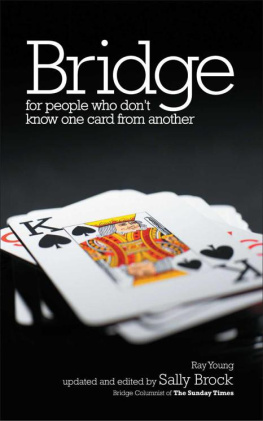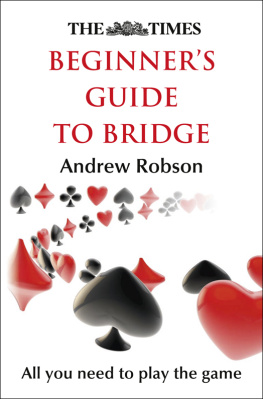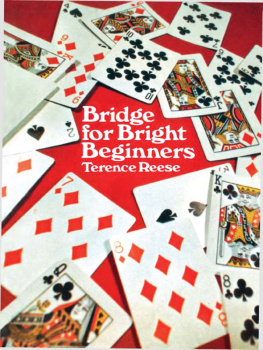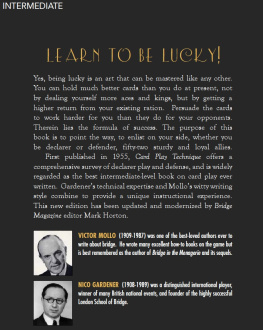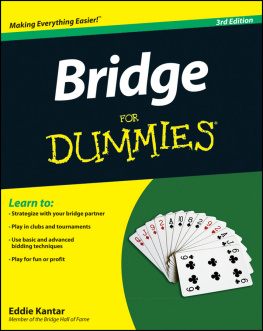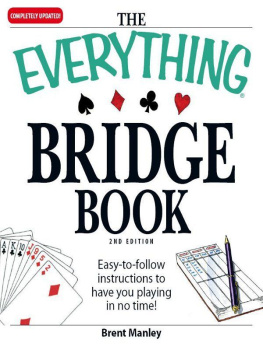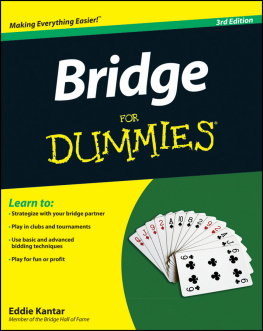Dorothy Hayden Truscott - Bid Better Play Better: How to Think at the Bridge Table
Here you can read online Dorothy Hayden Truscott - Bid Better Play Better: How to Think at the Bridge Table full text of the book (entire story) in english for free. Download pdf and epub, get meaning, cover and reviews about this ebook. year: 2006, publisher: Baron Barclay, genre: Home and family. Description of the work, (preface) as well as reviews are available. Best literature library LitArk.com created for fans of good reading and offers a wide selection of genres:
Romance novel
Science fiction
Adventure
Detective
Science
History
Home and family
Prose
Art
Politics
Computer
Non-fiction
Religion
Business
Children
Humor
Choose a favorite category and find really read worthwhile books. Enjoy immersion in the world of imagination, feel the emotions of the characters or learn something new for yourself, make an fascinating discovery.
- Book:Bid Better Play Better: How to Think at the Bridge Table
- Author:
- Publisher:Baron Barclay
- Genre:
- Year:2006
- Rating:4 / 5
- Favourites:Add to favourites
- Your mark:
- 80
- 1
- 2
- 3
- 4
- 5
Bid Better Play Better: How to Think at the Bridge Table: summary, description and annotation
We offer to read an annotation, description, summary or preface (depends on what the author of the book "Bid Better Play Better: How to Think at the Bridge Table" wrote himself). If you haven't found the necessary information about the book — write in the comments, we will try to find it.
Bid Better Play Better: How to Think at the Bridge Table — read online for free the complete book (whole text) full work
Below is the text of the book, divided by pages. System saving the place of the last page read, allows you to conveniently read the book "Bid Better Play Better: How to Think at the Bridge Table" online for free, without having to search again every time where you left off. Put a bookmark, and you can go to the page where you finished reading at any time.
Font size:
Interval:
Bookmark:
How many bridge players realize that our game, which seems so modern, has a long history behind it.
Playing cards were used in China as long ago as A.D. 979 although, sadly, the legend that they were invented by the Emperor to amuse his concubines has no validity. Some three hundred years later they appeared in Venice, possibly introduced by Marco Polo on his return from China. During the next century they spread rapidly throughout Europe and were well on time to catch the first boat to America. Legend tells us that Columbuss sailors threw their playing cards overboard in superstitious terror during a raging Atlantic storm. Later, on dry land, they regretted their rashness and made new ones out of leaves.
Playing cards reached England early in the fifteenth century and it was here that the ancestor of modern bridge was born. This early game was called variously triumph, trump, ruff and honours, whisk and swabbers, and whisk. The earliest recorded reference to the game is in 1529, but it is clear that it had been played long before this.
By the seventeenth century the game, by then called Whisk or whist, had become very popular particularly in London. Just as today, the game was played by four people, the two sitting opposite being partners. Thirteen cards were dealt to each player, and the score was determined by the number of tricks won above and beyond the first six tricks, which became known as the book.
There was no bidding, and trump was determined by turning up the last card dealt. There was no dummy exposed which made whist much more difficult than bridge. (In case you do not believe this, try playing bridge without a dummy.)
In the coffee-houses of London it was common to have a game of whist in progress with a ring of kibitzers standing around the table anxious to bet with the players or with each other. It resembled a miniature stock exchange, and wagers were laid on anything from the play of a card to whether it would rain tomorrow. It was, in fact, a group of whist players at Edward Lloyds Coffee House who in their spare time founded the famous Lloyds of London.
Such was the lively atmosphere when Edmond Hoyle (1672-1769) arrived on the scene. A barrister of good family and education, he became the first professional whist teacher. He wrote the first book devoted to the game and it rapidly became a best seller going through many editions. Much of what he wrote on card play is still applicable today.
Before Hoyles time even the basic finesse was understood only by experts or those in contact with experts. Now it was available to all. As a result the popularity of the game grew by leaps and bounds, particularly among the ladies and gentlemen of society. Whist had become a highly respected, intellectual pursuit. Hoyle established the tradition of law and order in card-play and the expression according to Hoyle became part of the English language.
Perhaps the most famous hand in the entire history of bridge is the one said to have been dealt over two hundred years ago in the gaming rooms at Bath, England, to the Duke of Cumberland.
| NORTH 10 9 8 7 6 5 4 3 2 A Q 10 8 | |
| WEST A K Q A K Q J A K K J 9 7 | EAST J 10 9 8 7 6 10 9 8 7 6 Q J |
| SOUTH 5 4 3 2 5 4 3 2 6 5 4 3 2 |
The Duke held the West hand in the diagram and incredible though it may appear, he never took a single trick.
Clubs were trumps and the Duke had the opening lead. In an effort to draw trumps as quickly as possible he led the seven of clubs. North won with the eight and led a diamond which South ruffed. South returned a trump covered by the nine and ten. Another diamond ruff put South in again to lead his last trump. North won, drew the Dukes last trump and claimed the balance with his seven established diamond winners.
On this hand the Duke lost twenty thousand pounds, the equivalent today of over a million dollars. Of course the Duke was swindled. This hand was used by hustlers of the eighteenth and nineteenth centuries to take advantage of the betting habits of the day. The actual cards can be found in one of Hoyles editions published long before the Dukes disaster.
From England, whist soon spread throughout most of Europe and the United States. No history of the game, however short, can fail to mention the famous French expert, Guillaume Deschapelles (1780-1847). He is described by his contemporary, James Clay, the English whist authority, as the finest whist player beyond comparison the world has ever seen. Soldiering in one of the wars of the time he lost his right hand, severed at the wrist. Nevertheless he continued to play whist, chess, and more remarkably, billiards. Many bridge experts have been excellent chess players, and many chess experts have been excellent bridge players. But Deschapelles was acknowledged as the finest whist player and the finest chess player of his day.
Although he contributed much to the science of whist, Deschapelles is remembered chiefly as the inventor of the coup which bears his name. This is the deliberate sacrifice of a high unsupported honor in order to force an entry into partners hand.
| NORTH A J 6 5 4 3 2 K Q J 10 9 8 | |
| WEST 4 3 2 Q 3 2 K Q J 10 9 4 2 | EAST Q 7 6 5 K 7 6 5 4 A 7 6 5 |
| SOUTH A K J 10 9 8 10 9 8 8 7 A 3 |
Against a contract of four spades West leads the diamond king to Easts ace. What should East return at trick two?
The only return to beat the contract is the king of hearts, a Deschapelles coup. With any other return, West will never get in to cash his diamond winner. Try it.
The next great name to appear on the whist scene is that of Henry Jones (1831-1899) of London, better known by his pseudonym of Cavendish. Author of many books on the game, he had more influence on whist than any writer since Hoyle. Among his contributions to the science of the game was the fourth-best lead, which has remained standard to this day. Cavendish devised and directed the first duplicate game, in London in 1857.
Toward the end of the nineteenth century, a variation of whist was introduced called bridge. Instead of turning up the last card to determine trump, the dealer was allowed to chose the trump suit or notrump if he preferred. He also had the option of passing the decision to partner. Doubles and redoubles were permitted ad infinitum, introducing an undesirable gambling element. Another difference, and a crucial one, was that in bridge the dummy was exposed. This made the play more scientific and whist authorities actually recommended bridge to their pupils as an aid to improving their whist.
About 1904 the element of competitive bidding was introduced: All four players could now bid in turn as high as they wanted for the privilege of naming the trump suit. Called auction bridge, this new variation quickly supplanted bridge, but the parent game, whist, continued to be played side by side with auction.
Further experiments, first by some English officers in India and then in France during World War I, produced a vital improvement: To score bonuses for games and slams you had to bid them. In 1925, on a cruise through the Panama Canal, Harold S. Vanderbilt combined this feature with a new scoring system including the idea of vulnerability and called it contract bridge. Thanks to Vanderbilts social position and tremendous reputation in the bridge world, contract bridge was immediately accepted and soon eclipsed all other forms of the game.
The credit for making contract bridge an international success must go to the dynamic Ely Culbertson (1891-1955). Expert player, author of an enormous number of bridge books, founder of
Font size:
Interval:
Bookmark:
Similar books «Bid Better Play Better: How to Think at the Bridge Table»
Look at similar books to Bid Better Play Better: How to Think at the Bridge Table. We have selected literature similar in name and meaning in the hope of providing readers with more options to find new, interesting, not yet read works.
Discussion, reviews of the book Bid Better Play Better: How to Think at the Bridge Table and just readers' own opinions. Leave your comments, write what you think about the work, its meaning or the main characters. Specify what exactly you liked and what you didn't like, and why you think so.



